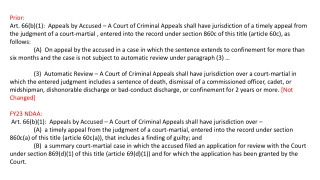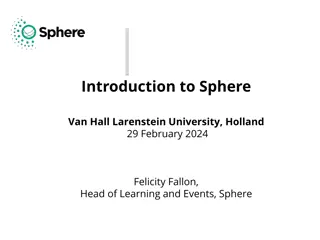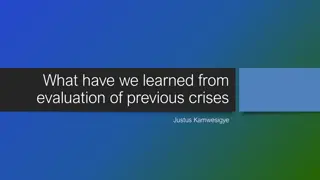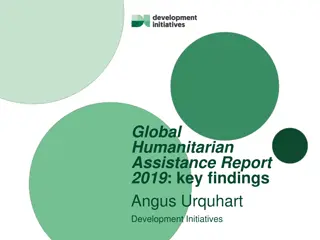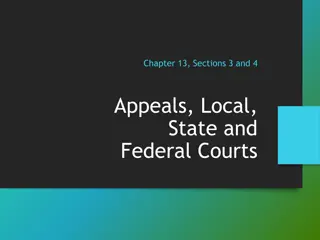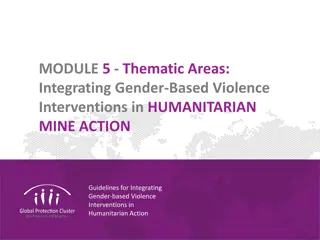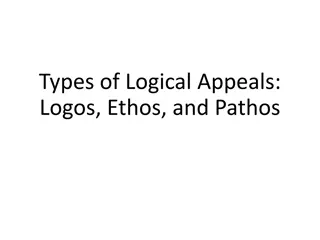Humanitarian Appeals Planning: Key Considerations and Core Requirements
This presentation focuses on key considerations for creating credible and compelling humanitarian appeals, highlighting the importance of setting boundaries, prioritizing effectively, and telling engaging stories. It also delves into core requirements such as articulating clear needs, reflecting community voices, and outlining response strategies. Important aspects like monitoring, inclusivity, and protection measures are addressed to ensure a people-centered and quality response.
Download Presentation

Please find below an Image/Link to download the presentation.
The content on the website is provided AS IS for your information and personal use only. It may not be sold, licensed, or shared on other websites without obtaining consent from the author.If you encounter any issues during the download, it is possible that the publisher has removed the file from their server.
You are allowed to download the files provided on this website for personal or commercial use, subject to the condition that they are used lawfully. All files are the property of their respective owners.
The content on the website is provided AS IS for your information and personal use only. It may not be sold, licensed, or shared on other websites without obtaining consent from the author.
E N D
Presentation Transcript
ASSESSMENT, PLANNING AND MONITORING BRANCH A Lightened HPC: Key Considerations & Content Heads of Office
01 KEY CONSIDERATIONS
A THREEPRONGED APPROACH FOR CREDIBLE & COMPELLING HUMANITARIAN APPEALS Make our humanitarian appeals as credible, clearly defined and well-prioritized as possible through rational boundary- setting and clear prioritization Advocate firmly with development actors to assist the people who we no longer serve and/or who would benefit from resilience programming Tell a compelling story about humanitarian needs and our humanitarian imperative to respond
CORE REQUIREMENTS - HNO 01 02 03 04 Tell a clear & compelling story Reflect the voices of diverse affected communities and groups. Describe the scale, scope & magnitude of the crisis in human terms. Use key facts, figures & visuals that you want the reader to remember. Highlight locations & groups that are hardest-hit (severity). Provide the PiN & break it down Your PiN should reflect the humanitarian needs in the country (JIAF 2.0) Describe/visualize the PiN and trends, incl. providing a visual breakdown/ disaggregation [can be ANNEXES]: across sectors; by sex, age and disability; by relevant groups of people e.g IDPs; geographically. Highlight info that informs response planning, incl: main types of needs (as expressed by communities); where needs are most severe (& if/how this has evolved over time); specific needs of different groups; high likelihood/impact risks, that should be planned for; Any other info that can directly inform response (e.g. are people mobile, etc.) Document & annex your methodology Provide indicators used to calculate the PiN and severity. Explain how humanitarian needs were assessed & the sources (e.g. MSNA, secondary data, etc) Describe (if you wish) in more detail the building blocks of your analysis & narrative (e.g. shocks, impact, context JIAF 2.0 module)
CORE REQUIREMENTS - HRP 01 05 02 03 04 Briefly explain your response strategy What are the 5-6 agreed elements of the collective response strategy for the year ahead, incl: Who will be targeted (and why)? based on HNO unit of analysis How will you respond (modalities) and why? What are the boundaries of the planned response and how does it complement others? Demonstrate the robustness of your $ ask & ability to implement Explain how you calculated the financial requirements Showcase capacity to implement & highlight how any access challenges will be addressed. Describe how you will monitor & adapt the response Link to a monitoring framework (linking Strategic Objectives to cluster objectives) Explain how monitoring will be conducted & which products will be published. Highlight how you will deliver a people-centered & quality response AAP Inclusivity (gender, age, disability & others) PSEA Protection Explain how you will prioritize What activities & geographic areas are the top priority? Which activities should donors direct their funding to FIRST? Are there any time- critical/time-sensitive activities which require funding by a specific moment to be achieved/implemented (e.g. pre-positioning due to seasonality)? LINK to the details.
FROM PiN TO TARGET BOUNDARY SETTING & PRIORITIZATION What are the *humanitarian* needs? (Humanitarian Needs Overview) Consider where the EMERGENCY is (using JIAF framing questions & analysis of shocks) Consider: Humanitarian Access; Response Capacity Complementarity with a) Govt action; b) devt action/plans Boundary setting Response outside the HRP (incl. other humanitarian actors (ICRC/MSF) + devt action) No Who are we planning to assist? (Humanitarian Response Plan) response Prioritization What is prioritized within the HRP (e.g. specific geographic areas, certain activities etc)?
02 POSSIBLE HNRP DOCUMENT STRUCTURE
0.A Cover Page States name of country & duration of the Appeal/Plan Urges people to pick up the document Conveys a sense of urgency Evokes need to respond Ensures dignity of those who are pictured
O.B. HNRP At-A-Glance (one page) Should provide a one-page summary of the key facts & figures for the context, including: PiN & PT (also broken down by cluster) NOTE: consider overlaying on severity of need. Substantive points to look for: As we set clearer boundaries re what goes in/out of the HRPs, there should be a bigger distinction between PiN and PT; Proportion of PT vs PiN should be highest in areas where needs are most severe. Requirements (also broken down by cluster) Gender, age and disability disaggregation (and other disaggregation relevant to your context, if appropriate, e.g. IDPs, HIV, urban/rural etc) use simple visual tools (e.g. doughnuts) to provide breakdowns, rather than pages of numbers. NOTE: This page should be easily printed and used by decision- makers and others to provide an overview of the crisis, planned response and funding requirements. It should have extremely limited text & be easily translated into multiple languages.
0.C Foreword OR Executive Summary (1pg) Covers the following key points in a compelling, clear and concise manner (no more than 1 page): Context/Needs: Highlights the humanitarian needs and trajectory of the crisis (1-3 para) Response Strategy: Sets out a clear vision / strategy for the humanitarian response (2-3 para) Boundary-Setting: Articulates the role of the plan (HRP) & what is in/out (1 para) Credibility: Emphasizes that the plan is achievable & cost-effective and why (e.g. capacity, adaptability, prioritization etc). Advocacy: Highlights what is required from the international community (e.g. funding the humanitarian response, political solution etc).
O.D Table of Contents Provides a clear Table of Contents, using bold for section headings
1.1. Crisis Overview (2-6pg) Tell a compelling narrative re the plight of affected people and how the crisis has evolved (note: this can build on HCT Key Messages. Use bold text to make the key point in the first line of each para, and elaborate in the rest of the para). Clearly outline the needs caused by the crisis, using key facts, figures & visuals. Include/reflect the following: PEOPLE S PRIORITIES: Highlight which humanitarian needs different groups of affected people consider a priority. Amplify the voices of diverse groups of affected people/share feedback from affected communities. MOST AFFECTED GROUPS: Within the overview, highlight unique needs of different groups of people (e.g. by gender, age, disability, displacement and/or other relevant groups (urban/rural, LGBTQI+ etc). Which groups are most impacted by the crisis? Why? How? What barriers to aid may they be facing? [Consider using a visual summary of this info] Ensure you include protection needs/risks. If relevant, insert a timeline of the crisis. Use simple to understand visuals to highlight needs. If you have produced a full HNO, link to it from here. NOTE: Background elements e.g. political, socio-cultural, socio-economic/market, demographic profile, legal and policy frameworks, security environment, infrastructure & technology and environmental profile (i.e. JIAF 2.0 module 1) do not need to be included in the document itself. If available, this can be linked to from the main document.
Part 1. Humanitarian Needs Overview
1.2 Analysis of Humanitarian Needs [& Risks] (1-2 pg) Provide analysis (accompanied by clear visuals) regarding humanitarian needs in the context, including (in no particular order): SEVERITY: Where are needs most severe? Why? [This should be accompanied by a visual clearly highlighting based on JIAF 2.0 results where inter- sectoral needs are highest] TRENDS: How have humanitarian needs evolved over time (especially PiN) in the context? What is driving the trend? NOTE: If there is a major change for 2024 (especially, if you have redefined *humanitarian* need) explain WHY. [IF APPROPRIATE] OUTLOOK/RISKS: Depending on appropriateness, highlight the outlook/risks/ projections/scenarios, including based on seasonality and vulnerabilities of specific groups.. NOTE: If your context is politically challenging, consider developing a separate note on this which is not published/publicly available, but informs ICCG/HCT planning.
1.3 PiN Breakdown [LINK OR ANNEX] Provide a detailed breakdown of the PiN, [NOTE: consider using visual cues to highlight key information for the reader to be aware of (e.g. size of bubbles to show where needs are highest, trend arrows to show change since previous period etc)] Should include: GEOGRAPHIC BREAKDOWN (to appropriate admin area); TRENDS (i.e. changes since last HNO); GENDER, AGE & DISABILITY BREAKDOWN, where available (and estimates if not available); STATUS BREAKDOWN (i.e. IDP, resident etc), if appropriate in the context. This table does not need to be included in the main document. It can be included as a link or Annex.
Part 2. Humanitarian Response Plan
2.1 Humanitarian Response Strategy (1-2 pgs) Articulate 3-6 key elements of theresponse strategy, including covering: THE ASK: Provide the $ required for the response and highlight any efficiencies in the response (e.g. common pipelines etc). SCOPE & BOUNDARIES: Outline how many people will be targeted, who they are and why they will be targeted. Highlight the relationship of the HRP to other strategies/plans in country (especially the UNSDCF, durable solutions and dev activities). If no gov or dev plans, how the response strategy aims to lay the groundwork for durable solutions.LINKS to any relevant planning for nexus approaches, durable solutions plans, etc PRIORITIZATION: Illustrate how the planned response be prioritized based on need, this can include: a) geographic prioritization; b) prioritization of activities (see e.g. here), taking into account people's ability to access info and aid; c) time-sensitive activities that should be funded at a certain point in the year,d) and other forms of prioritization. AREAS OF FOCUS: Are there specific areas of focus for the response in 2024 (e.g. delivering in hard-to-reach areas; localizing the response; seasonality/time-sensitive actions + Early/Anticipatory Action re known risks; centrality of protection (incl. GBV), AAP, PSEA, gender, age and disability-sensitivity and related). NOTE: You can provide a summary here and link to more details (e.g. a full localization strategy).
2.2 Strategic Objectives (1-2 pgs) Outline the scope of the humanitarian response: For each Strategic Objective (SO), highlight: WHATthe Strategic Objective is; HOW MANY PEOPLE will be targeted under this objective [notes: 1) if feasible and appropriate, provide a breakdown e.g. by specific groups, gender/age/disability etc explain how this was calculated (e.g. a % based on census, or something more operationally relevant); 2) if there is overlap in people targeted under the different SOs, explain]; WHEREpeople will be targeted [note: if feasible, show the difference between PiN vs PT for each SO]; [IF POSSIBLE] HOW MUCH funding is needed to deliver against each Strategic Objective. NOTE: The full Monitoring Framework includes the Strategic Objectives, Cluster Objectives, Cluster Activities, Indicators & Targets; it should be made available through a link to the logframe page of the HRP in HumanitarianAction. During the year, this page will provide real-time results data. On your SO page, include the text & link i.e. The full Monitoring Framework can be found online here
2.3 Planning Assumptions, Operational Capacity & Access, & Response Trends (1-2 pgs) Briefly provide an overall picture of operational feasibility and ability to respond (i.e. convince the audience that we would be able to implement the HRP if fully-funded), incl: PLANNING ASSUMPTIONS that will impact implementation; OPERATIONAL CAPACITY toimplement the HRP (note: this should be accompanied by a visual of actual operational presence & key figures around this e.g. local vs international capacity etc. For more detailed breakdowns of partner type, location etc, provide a link) ACCESS CONSTRAINTS & CHALLENGES that will impact delivery highlighting any key trends & how the response will account for the challenges(note: preferably overlay operational capacity/ people targeted on top of access constraints/challenges to provide overall picture of operational feasibility); RESPONSE TRENDS, including: 1) Response highlights, gaps & challenges from the previous year [can be a breakout box]; and 2) broader response trends over the year [can be a visual of PT vs PiN and $ required trends] [if needed] COORDINATION set-up and approach, including any elements that support participation of affected people, localization and related efforts (e.g. local NGOs on HCT, area-based coordination approaches etc) [NOTE: This can be a link to a coordination org chart etc & doesn t need to be in the doc]
2.4 Inclusive & Quality Programming (1-2 pgs) Briefly (i.e.1-2 paras each) outline the HCT s approach on the following issues: ACCOUNTABILITY TO AFFECTED PEOPLE & PEOPLE-CENTRED RESPONSE: highlight how communities were consulted to determine the humanitarian response strategy & plan; how communities and local actors will be included in the decision-making process throughout the response implementation; outline the (preferably collective) two-way communication channels between communities & humanitarian actors; how community perceptions, feedback and complaints will be collectively handled and analyzed to influence decision-making leading to response adjustment and course correction; highlight any other features of the response that make it more people-centred (e.g. shifting response capacity &/or coordination closer to people impacted by the crisis etc) [Note: link to your AAP Strategy, if there is one] PROTECTION FROM SEXUAL EXPLOITATION AND ABUSE: highlight the HCT s collective approach to PSEA and how this is integrated in coordination mechanisms and the response, using a victim-centred approach [Note: link to your Inter-Agency PSEA Action Plan, which should meet the expectations of the SG Bulletin and IASC PSEA commitments]; GENDER, AGE, DISABILITY & OTHER DIVERSITIES - SENSITIVITY & EMPOWERMENT: Outline how the humanitarian response will factor in the unique needs of different people AND (if appropriate) how it will seek to empower different groups (e.g. women/girls; people with disabilities) within the response (e.g. through specific stakeholder platforms etc). [Note: link to any more detailed elaborations on these issues, such as gender strategies/road maps etc]
2.5 Cost of the Response (1/2 to 1 pg) Briefly outline: COSTING METHODOLOGY: explain which costing methodology was used for the HRP (project- costed, activity/unit-costed or hybrid); For project-costed HRPs, provide info on the project submission & vetting process (e.g. cluster defences, inter-cluster defences etc) how were projects selected for inclusion? For unit-costed HRPs, present data and methodology used to estimate costs; For hybrid-costed HRPs, highlight which elements of each were used and how the $ figures were arrived at. CHANGES IN THE COST OF OPERATING: highlight any *major* changes in operating costs which may justify a change in the overall ask of the HRP (e.g. fuel price rises, inflation etc).
2.6 [Optional] Consolidated overview on the use of multipurpose cash Consider appropriateness, feasibility and relevance of multipurpose cash, including feedback from affected people, where relevant; Describe how the use of multipurpose cash will be coordinated and contribute to/interface with inter- and multi-sectoral and sectoral response approaches and modalities; Outline how MPC will contribute to response objectives and provide details of the target population, geographic focus and monitoring plans; Describe applicable standards and calculations (including calculation of Minimum Expenditure Basket); and, if applicable, how this is adapted to specific/diverse groups of people. Provide consolidated financial requirements disaggregated by MPC portion (i.e. X % of total requirements MPC or $ amount) and targeting strategy; Outline how MPC and social protection assistance complement each other; Indicate key partners involved in coordinated use of MPC.
2.8 Monitoring Outline how the needs AND response will be monitored, including: SITUATIONAL MONITORING: highlight key assessment processes and/or dates which will be used to monitor needs (e.g. displacement tracking, IPC etc), as well as how assessments will be coordinated and tracked (Assessment Working Group etc) RESPONSE MONITORING: outline how collective response monitoring will be carried out, and using which indicators (note: you can link to the full logframe for the HRP, rather than including it inside the document!) MONITORING THE QUALITY & INCLUSIVENESS OF HUMANITARIAN PROGRAMMING: outline how: Community feedback will be received & integrated into the response / course corrections; Gender, age, and disability-sensitivity will be tracked in the response. Show a timeline for reports/updates that monitor the situation and response (e.g. Humanitarian Snapshot, Humanitarian Dashboard and, if applicable, Periodic Monitoring Report). Link to the HRP Monitoring Framework on HumanitarianAction (which provides access to live/real-time response data)
Part 3. Cluster/Sector Needs & Response
3.1 Cluster/Sector Pages Provide 1-2 pages per cluster/sector/AoR, which covers (one para each): SUMMARY OF NEEDS RESPONSE STRATEGY TARGETING & PRIORITIZATION PROMOTING QUALITY & INCLUSIVE PROGRAMMING (including AAP, PSEA and Gender as per slide 20) COST OF RESPONSE PLUS: PiN, PT, Requirements, # Partners Cluster Objectives & linkages to Strategic Objectives (and under the Cluster Objectives, include the following The cluster page, including indicators and activities, can be found online here NOTE: In addition to the text on the cluster page, it is critical that clusters provide their activities, indicators and targets, linked to their Cluster Objectives (and thereby to Strategic Objectives), which should come together in the Monitoring Framework and be entered in HPC-Tools. They will be available in the online cluster page in HumanitarianAction, which will provide real-time results data during the year. NOTE: Keep visuals together with the cluster pages (rather than separated out). NOTE: Each sector/cluster should provide the link to the online cluster page on HumanitarianAction. They may also link to a longer/more detailed strategy, if they so choose.
Part 4. [IF APPLICABLE] Refugee Response Plan [from HRP guidance].
End. How to Contribute & About Highlights: How to contribute (e.g. via the Response Plan, to the CBPF, to CERF etc) About (background to the document standard para) Where to get the latest updates (NOTE CHANGES: this section should show OCHA, HumanitarianAction and FTS. HumanitarianResponse has been discontinued and replaced with ResponseReliefWeb. (note: background colour should be in orange).


